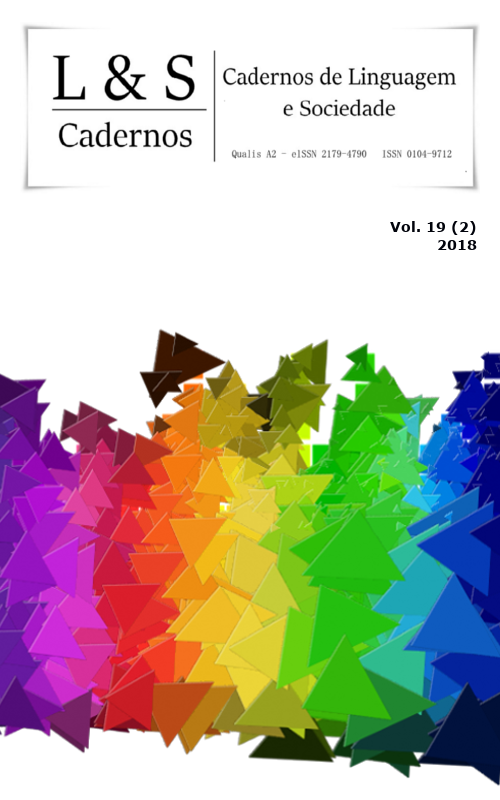THE IMPLICATIONS OF THE USE OF ENGLISH AS A LINGUAL FRANCA ON THE LINGUISTIC CHANGES OF THE COLLOQUIAL DIALECTS OF ARABIC
DOI:
https://doi.org/10.26512/les.v19i2.16894Palavras-chave:
Loanwords, Gender, Linguistic diversity, Language use, Sociolinguistic analysis, Saudi colloquial ArabicResumo
With the development of globalization and the emergence of global English, numerous studies have been concerned with the ways Arabic is influenced by English, the adoption of many English loanwords by Arab speakers and the dominance of English as a lingua franca in different Arab countries including Saudi Arabia. These studies generally investigate the effects of global English on the Arab linguistic and cultural identity. The majority of these studies tend to list what they refer to as risks of the dominance of English loanwords in Arabic and assert the importance of keeping Arabic pure from these words which are described asدخيل dakhil (literally meaning strange and outsider). Very few studies have been done on exploring the ways English loanwords are used in Saudi Colloquial Arabic (SCA) and the relationship between the use of English loanwords and some sociolinguistic variables such as sex, age, geographic location, and education. In the face of this, this article is concerned with exploring the relationship between sex and the use of English loanwords in Saudi Colloquial Arabic (SCA). In order to do this, the study is based on a corpus of English loanwords in Saudi Colloquial Arabic (SCA) with the purpose of investigating the frequency of English loanwords in the speeches of male and female speakers and describing the morphological adaptations used by male and female speakers. Results indicate that there are significant differences between Saudi male and female speakers in the use of English loanwords in terms of frequency, topics, and morphological adaptations. The sex or gender of the speaker is an important factor in determining the frequency, distribution, and the morphological adaptations of English loanwords in SCA.
Downloads
Referências
Abdel-Rahman, W. (1991). A Critical Linguistic Study of Lexical Borrowing in Arabic and English. Journal of King Saud University, 3(2), 33-66.
Abushihab, I. (2016). Foreign Words in Jordanian Arabic among Jordanians Living in Irbid City: The Impact of Foreign Languages on Jordanian Arabic. Journal of Language Teaching and Research, 7(2), 284-292.
Alahmadi, S. D. (2015). Loanwords in the Urban Meccan Hijazi Dialect: An Analysis of Lexical Variation according to Speakers’ Sex, Age and Education. International Journal of English Linguistics, 5(6), 34-58.
Alosh, M. (2005). Using Arabic: A Guide to Contemporary Usage. Cambridge Cambridge University Press.
Al-Sameray, A. (2011, December 8-10, 2011). The Influence of Biculturalism on Arabic Language. Paper presented at the Proceedings of the Linguistic Changes of Arabic in the Age of Globalization Al-Khalil, the West Bank.
Armstrong, N. (2005). Translation, Linguistics, Culture: A French”“English Handbook. Clevedon, Buffalo and Toronto: Multilingual Matters Ltd.
Auer, P. (2003). Code-switching in conversation : language, interaction and identity. London ; New York: Routledge.
Baker, M. (1987). Review of Methods Used for Coining NewTerms in Arabic. META, 32(2), 186-188.
Baugh, A. C., & Cable, T. (1989). A History of the English Language (3rd ed.). London: Prentice Hall International.
Booij, G. (2001). English as the lingua franca of Europe: A Dutch perspective. Lingua e Stile, 36(2), 347-357.
Brustad, K. (2000). The Syntax of Spoken Arabic: A Comparative Study of Moroccan, Egyptian, Syrian, and Kuwaiti Dialects. Washington: Georgetown University Press.
Campbell, L. (2013). Historical Linguistics: An Introduction (Third edition. ed.). Edinburgh: Edinburgh University Press.
Cannon, G. (1994). The Arabic Contributions to the English Language: An Historical Dictionary. Wiesbaden: Harrassowitz Verlag.
Carroll, T. (2013). Language Planning and Language Change in Japan : East Asian Perspectives.
Chejne, A. G. (1969). The Arabic language: its role in history: Minneapolis: University of Minnesota Press.
Coposescu, L. (2010). Discourse Analysis of Communication in International Companies. In A. James (Ed.), Globalization in English studies. Newcastle: Cambridge Scholars.
Corriente, F. (2008). Dictionary of Arabic and Allied Loanwords : Spanish, Portuguese, Catalan, Galician and Kindred Dialects. Leiden: Brill.
Crystal, D. (2003). English as a Global Language (2nd ed. ed.). Cambridge ; New York: Cambridge University Press.
Daher, J. (2003). Lexical Borrowing in Arabic and English. The Vocabula Review 5(5).
Darwish, H. (2015). Arabic Loan Words in English Language. Journal Of Humanities And Social Science, 20(7), 105-109.
Durkin, P. (2015). Borrowed Words: A History of Loanwords in English (First edition. ed.). Oxford Oxford University Press.
Evans, T. (1997). A Dictionary of Japanese Loanwords: Greenwood Publishing Group.
García, C. L. (2013). The English Language and Anglo-American Culture: Its Impact on Spanish Language and Society. Newcastle upon Tyne: Cambridge Scholars Publishers.
González, F. R. (1996). Spanish Loanwords in the English Language: A Tendency Towards Hegemony Reversal: Walter de Gruyter.
Gu, S. a. (2013). A cultural history of the Arabic language. North California; London: McFraland Publishers.
Hafez, O. (1996). Phonological and Morphological Integration of Loanwords into Egyptian Arabic. Égypte/Monde arabe, 27-28, 383-410.
Hashim, A. (2011, December 8-10, 2011). Standard Arabic and Recent Dialects in the Age of Globalization. Paper presented at the Proceedings of the Linguistic Changes of Arabic in the Age of Globalization Al-Khalil, the West Bank.
Haspelmath, M. (2009). Lexical Borrowing: Concepts and Issues. In M. Haspelmath & U. Tadmor (Eds.), Loanwords in the World's Languages: A Comparative Handbook (pp. 35-55). Berlin, Germany: De Gruyter Mouton.
Haspelmath, M., & Tadmor, U. (Eds.). (2009). Loanwords in the World's Languages: A Comparative Handbook. Berlin, Germany: De Gruyter Mouton.
Hassan, W. (2015). The Lexicalization of English Loanwords into Egyptian Arabic. In G. Senosiáin (Ed.), Lenguas, lenguaje y lingüística (pp. 243-259): Servicio de Publicaciones de la Universidad de Navarra.
Haugen, E. (1950). The Analysis of Linguistic Borrowing. Language, 26, 210-231.
Hock, H. H. (1991). Principles of historical linguistics (2nd ... ed. ed.). Berlin: Mouton de Gruyter.
Hoffer, B. L. (2002). Language Borrowing and Language Diffusion: An Overview. Intercultural Communication Studies, XI(4).
Holes, C. (2004). Modern Arabic: Structures, Functions, and Varieties Georgetown: Georgetown University Press.
Hui, Y., & Oh, M. (2015). Adaptation of English Stops into Mandarin Chinese. Linguistic Research, 32(2), 403-417.
Ibrahim, Z. (2006). Borrowing in Modern Standard Arabic. In R. Muhr (Ed.), Innovation and Continuity in Language and Communication of Different Language Cultures (Vol. 9, pp. 235-260). Frankfurt: Peter Lang.
Ibrahim, Z. (2009). Beyond Lexical Variation in Modern Standard Arabic: Egypt, Lebanon and Morocco. Newcastle upon Tyne: Cambridge Scholars Publishing.
Irwin, M. (2011). Loanwords in Japanese. Amsterdam; Philadelphia: John Benjamins Publishing Company.
Ismaeel, S. A. (2005). The Influence of Globalization on Arabic. International Islamic University, Malaysia.
James, A. (2010). Globalization in English Studies. Newcastle: Cambridge Scholars.
Kachru, B. B. (1983). The Other Tongue: English Across Cultures. Oxford: Pergamon.
Kaplan, R. B., & Baldauf, R. B. (2005). Language Planning and Policy in Europe: Clevedon : Multilingual Matters, 2005-.
Kashgary, A. (2014). The paradox of translating the untranslatable. Riyadh: Saudi Arabia: Jarir
Kay, G. (1995). English Loanwords in Japanese. World Englishes, 14(1), 67-76.
Kemmer, S. (2004). Loanwords: Major Periods of Borrowing in the History of English Retrieved April 20, 2016, 2016, from http: // www .ruf. rice.edu/ Kemmer/ Words/ loanwords.html
Khalil, G. (1984). Lexical Borrowing From French And English By Egyptian Colloquial Arabic. Unpublished PhD, American University, Cairo.
Labov, W. (2011). Principles of Linguistic Change: Cognitive and Cultural Factors. Oxford: Wiley-Blackwell.
Lancioni, G., & Bettini, L. (2011). The word in Arabic. Leiden: Extenza Turpin.
Maxos, H. (2000). Modern Arabic Grammar. Damuscus: Dar Al-Kitab.
Maynard, S. K. (1997). Japanese Communication: Language and Thought in Context. Hawaii: University of Hawaii Press.
Meurs, F., & Hornikx, J. (2014). English Loanwords and their Counterparts in Dutch Job Advertisements: An Experimental Study in the Assocition Overlap In E. Zenner & G. Kristiansen (Eds.), New Perspectives on Lexical Borrowing: Onomasiological, Methodological and Phraseological Innovations (pp. 171-190): Walter de Gruyter.
Meyerhoff, M. (2015). Introducing sociolinguistics. London: Routledge.
Miura, A. (2011). English Loanwords in Japanese: A Selection: Tuttle Publishing.
Morrow, P. R. (2007). The Users and Uses of English in Japan. World Englishes, 6(1), 49”“62.
Moshref, O. (2009). Grammatical Gender Assignment of English and French Loan Words in Egyptian Arabic. Arabic Linguistics Symposium Austin, Texas, United States of America.
Myers-Scotton, C. (2006). Multiple Voices: An Introduction to Bilingualism. Oxford: Blackwell.
Ngom, F. (2002). Linguistic Borrowing as Evidence of the Social History of the Senegalese Speech Community. International Journal of Sociology of Language, 158, 37-51.
Philips, S. U., Steele, S., & Tanz, C. (1987). Language, Gender and Sex in Comparative Perspective. Cambridge: Cambridge University Press.
Qasim, M. (2009). At-tarjamatu fil-’asr il-’abasÄ« wa-dawraha fi tanaw‘i il-‘Å«lÅ«mi wa ma‘arifi ‘inda al-‘arab (Translation in the Abbasi Age). Afaq ath-thqafah wat-turath (Horizons of Culture and Heritage), 66, 55-78.
Qinai, J. (2000). Morphophonemics of Loanwords in Arabic. Studies in the Linguistic Sciences 30(2).
Romaine, S. (1989). Bilingualism. Oxford: Basil Blackwell.
Rosenhouse, J., & Kowner, R. (2013). Globally Speaking: Motives for Adopting English Vocabulary in Other Languages: Multilingual Matters.
Ryding, K. C. (2005). A reference grammar of modern standard Arabic. Cambridge: Cambridge University Press.
Sachdev, I., & Giles, H. (2004). Bilingual accommodation. In T. K. Bhatia & W. C. Ritchie (Eds.), The Handbook of Bilingualism (pp. 353-378). Oxford: Blackwell.
Stanlaw, J. (1983). English in Japanese Communicative Strategies. In B. Kachru (Ed.), The Other tongue : English across cultures. Oxford: Pergamon.
Suleiman, S. (1985). Jordanian Arabic between Diglossia and Bilingualism: Linguistic analysis: John Benjamins Publishing.
Talbot, M. M. (2010). Language and Gender (2nd ed. ed.). Cambridge: Polity.
Taylor, W. (1933). Arabic Words in English. London: Clarendon.
Thomason, S. G. (2001). Language Contact. An Introduction. Edinburgh: Edinburgh University Press.
Trudgill, P. (2000). Sociolinguistics: An Introduction to Language and Society. London: Penguin Books.
Versteegh, C. H. M. (2014). The Arabic language. Edinburgh: Edinburgh University Press.
Versteegh, K. (2014). The Arabic Language (Second Edition ed.). Edinburgh: Edinburgh University Press.
Wardhaugh, R., & Fuller, J. M. (2015). An Introduction to Sociolinguistics (Seventh edition. ed.). Chichester: Wiley Blackwell.
Watson, J. C. E. (2002). The phonology and morphology of Arabic. Oxford: Oxford University Press.
Winter-Froemel, E. (2007). Loanword Adoption versus Adaptation: Two Types of Conformity. Newcastle Working Papers in Linguistics.
Xia, X., & Miller, E. (2013). Reconstructing gender ideologies of English loanwords in Chinese. Language & Communication, 33(3), 214”“220.
Yarshater, E. (1998). The Persian Pressence in the Islamic World. In R. G. Hovannisian & G. Sabagh (Eds.), The Persian Presence in the Islamic World (pp. 4-125). Cambridge: Cambridge University Press.
Yule, G. (2006). The study of language (3rd ed.). Cambridge: Cambridge University Press.
Zenner, E. (2015). A sociolinguistic analysis of borrowing in weak contact situations: English loanwords and phrases in expressive utterances in a Dutch reality TV show. International Journal of Bilingualism, 9(3), 333-346
Downloads
Publicado
Como Citar
Edição
Seção
Licença
Autores/as que publicam nesta revista concordam com os seguintes termos:
Autores/as mantêm os direitos autorais e concedem à revista o direito de primeira publicação, sendo o trabalho simultaneamente licenciado sob a Creative Commons Attribution 4.0 International license que permite o compartilhamento do trabalho com reconhecimento da autoria do trabalho e publicação inicial nesta revista.



